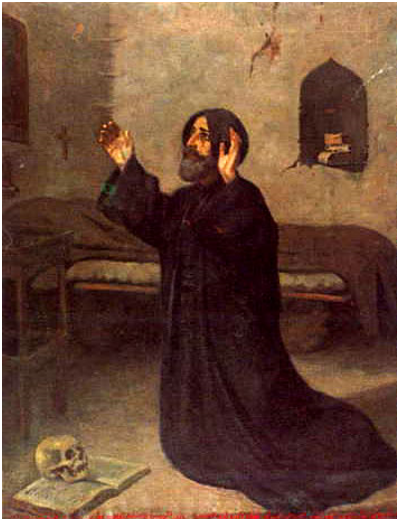Saint Sharbel

Saint Sharbel was born in 1828. He entered St. Maron Monastery in Lebanon in 1853 and lived there as a monk and priest for 16 years. Then, hearing the call of God to a life of greater solitude and prayer, he was given permission to become a hermit. For the next 23 years he gave himself in total dedication to God and the Church in his hermitage by a life rooted in the Scriptures, love for the Eucharist and the Mother of God.
After living a holy life hidden in Christ, he died on December 24, 1898. On the evening of his funeral, his superior wrote: "Because of what he will do after his death, I need not talk about his behavior." A few months later, a bright light was seen surrounding his tomb. The superiors ordered the tomb to be opened, and they found his body perfectly preserved. Scientific experts and doctors are unable to explain this. Since his death, thousands of recorded miracles have been attributed to his intercession—so many, in fact, that he is known as the "Wonderworker of the East."
In 1965, at the close of the Second Vatican Council, Pope Paul VI declared: " … a hermit of the Lebanese mountain is inscribed in the number of the blessed … a new eminent member of monastic sanctity is enriching, by his example and his intercession, the entire Christian people… May he make us understand, in a world largely fascinated by wealth and comfort, the paramount value of poverty, penance and asceticism, to liberate the soul in its ascent to God." On October 9, 1977, Pope Paul canonized St. Sharbel at the World Synod of Bishops.
Saint Nimtullah Hardini

Youssef Kessab, son of Gergis Kessab and Mariam Raad, was born in Hardine, Lebanon, in the year 1808, in a devout Maronite Catholic family. As a youngster he attended the school of the monastery of the Maronite Lebanese Order of Saint Anthony, in Houb (1816-1822). After that he joined the monastic life in that same Order, and put on the novitiates’ uniform in the monastery of Saint Anthony the Great, Gazo d’Hayo (pronounced Kozhayya in Lebanese, from the Aramaic Gazo d’Hayo, meaning the treasure of life, a term that is often used in Aramaic Maronite terminology to refer to the Sacristy, where the Eucharist and the martyrs and saints relics are reserved), in November 1828, taking the name of brother Nimatullah (which means the grace of God). He spent some peaceful time there growing up in holiness and learning some skillful trades, such as binding books in the monastery’s printing house. On November 14, 1830, Nimatullah professed his solemn vows after he finished his theology studies. He was ordained to the sacred priesthood in the monastery of Saints Qobrianos and Youstina, in Kfifane (Batroun, North Lebanon), on December 25th, 1833, by the laying of hands of his Excellency bishop Simon Zouein.
He was elected a Counselor (Provincial) by his Order’s chapter three times in 1845-1848, 1850-1853, and 1856-1858. He always worked in binding books, even when he was a Counselor in the General Administration of his Lebanese Maronite Order. He was a teacher in several schools run by his Order, especially the one annexed to the Kfifane monastery. One of his best students was Saint Sharbel Makhlouf, who studied under Saint Nimatullah from 1853 - 1858.
Nimatullah died in the monastery of Saints Qobrianos and Youstina, on December 14, 1858, after being extremely ill for years. After an order from Patriarch Boulos Massad, and because of the demands of the increasing visitors, his uncorrupted body was closed in a sealed coffin and moved to a separated cell in the monastery in 1862. On May 4th, 1926, his beatification case was presented to the Holy See in Rome.
On May 18, 1996, according to the orders of Patriarch Mar Nisrallah Peter Sfeir, a committee was appointed to examine Saint Nimatullah’s body, which was moved to a new coffin, then placed in a new room in the same monastery in March 26, 1998. God granted his people many healing miracles through the intercession of Saint Nimatullah, among these were: making a blind man see, a paralyzed man to walk, bringing back to life a child who was dead, and healing another child from cancer and other neurotic illnesses.
On May 10, 1998, Pope John Paul II, presided over the great celebration of his beatification. He was canonized as a Saint on May 16, 2004.

The information in "Our Faith and Saints" was taken from the following websites:
